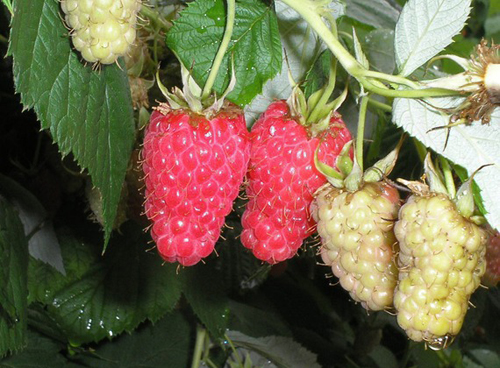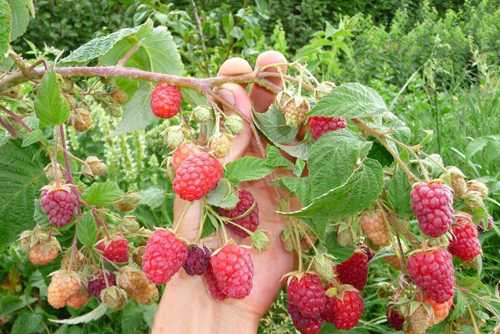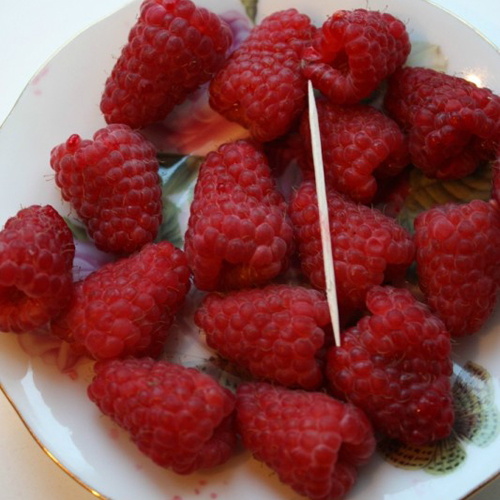Raspberry variety Pride of Russia
In no way do I want to denigrate domestic varieties. But sometimes one gets the impression that some are simply "unfinished", little time was devoted to selection, and the main task was to come up with loud names. And why do tens of years have passed since the release of a new raspberry on the market, and people have no clear opinion or objective assessments? Why are some data indicated in the State Register, but in practice something completely different comes out? With the specified good frost resistance, the plants freeze out, with the announced high keeping quality and transportability of berries in real life, they wrinkle, flow, and the like. And why does a gardener need to either buy a paid database or be a real hacker in order to view the complete data on plants patented in our country? But there are really worthy specimens that delight their owners from year to year and give reason to admire themselves. But can you really be proud of the Pride of Russia? More about this in our article below.

History of creation
The large-fruited summer raspberry variety Pride of Russia was bred at the Moscow Institute of Horticulture and Nursery (VSTISP). In 1992, Russian breeders headed by Professor V. V. Kichina crossed two varieties - "Stolichnaya" and the donor "Shtambovy-20". Among the experimental plantings in 1996, seedlings with number T4 were selected, corresponding to the required characteristics. Then, having made sure of the stability of the obtained varietal qualities in new generations, the raspberries began to be propagated and prepared for open sale. Since 1998, it has been officially launched as a new variety under the name Pride of Russia.
Often our heroine is confused with other brainchilds of Kichina, namely the Inaccessible (partly from the similar names of the T4 and P-34 license plates). And also it is often called the Giant. But this is completely wrong. These varieties are similar, but not in all. In general, when choosing a name, the originators considered such options as "Impeachment" and even "Monica", in honor of the high-profile scandal of those times, in which Monica Lewinsky participated. Often, confusion arises from the fact that part of the hybrid raspberry seedlings used in the selection of the variety is passed on for testing by "reputable" gardeners. And already they call them by their big names and bring them to the market for subsequent sale.
Description
The pride of Russia is the mid-early ripening period, the beginning of the collection falls on July 8-10. In the southern regions, it begins to color in the first decade of June, and blooms in May. For example, in the north and in the center of Ukraine it will sing from the 20th of June. And in Siberia, it blooms from the 10th of June, and the beginning of ripening occurs in the first decade of July. The fruiting period is extended. It lasts on average up to one month, the entire crop is harvested in 5-6 samples. Depending on the region, fruiting can continue until the end of August. In a warm autumn, raspberries can partially show remontability (a small number of fruits appear on already fruiting shoots in some places). But this is now happening on many other varieties and species. The reason is the widespread climate change towards warming.

The plant has medium vigor. The bush is compact growing, compressed type, erect shoots, mostly 1.5-1.8 meters high. They are absolutely studless and without a wax coating, slightly pubescent, practically non-beating, medium-thick, 1.5-2 cm wide. Often in the descriptions of domestic varieties, the term "tapering" is present. To make it clearer for the readers, the escape is a gradual change in the diameter of the trunk, the shoot from the base to the top. Consequently, a non-escape is a shoot, the width of which near the base is almost the same as at its end. Or its change is not significant at all.
The pride of Russia forms quite a few shoots, 10-12 pieces per season, and produces plenty of root shoots.The stems of the first year are juicy green in color, in the second year they ripen and become woody, acquiring a light brown tint. A rosette of leaves is formed at their tops.
Laterals (fruit twigs) are medium-long, green in color, without a wax coating, "ideally" up to 30 fruits are formed on them. The laterals can sometimes break off under the weight of very large berries. The leaves of the Pride of Russia are large, serrated, slightly twisted. They are strongly corrugated, crenate, with sharp edges, deep green, and whitish below. The sheet consists of three leaves.
Abundant flowering begins in May - June, depending on the region. The flowers are very large, as for raspberries, 1.5-2.5 cm in diameter, collected in numerous brushes of 10-15 pieces. The variety is self-pollinated, but cross-pollination with other varieties will only improve the quality of the fruit. For example, with the early Polish Lyachka.
The berries are large and very large, fleshy, weighing 4-12 grams. Sometimes they can be poured to simply huge sizes, showing on the scales amazing, like for raspberries, indicators - up to 18 grams. But the Pride of Russia, like many large-fruited representatives of raspberries and blackberries, often have twisted, deformed and double berries. Moreover, the halves of double fruits can ripen unevenly. One of the reasons is the direct dependence on weather conditions, and in particular the effect of too high temperatures at the time of ovary and fruit development.

Fruits are wide, elongated, blunt-conical in shape. Drupes are medium and small, homogeneous, tightly interconnected. The seeds in them are few, not large, practically not felt during use. The berries of the variety are deep red, dark red at the stage of full ripeness. The pulp is medium-dense, juicy. The surface of the fruit is beautiful, velvety, with shine. But the skin is thin and not very elastic. This is one of the reasons for the low commercial quality of the berries. After ripening, the fruits hang on the bush for a rather long time, without crumbling. But unripe berries can crumble when picked, and overripe berries can rot if not picked on time. Especially in cool and damp weather. Plus, frequent rains during harvest add acid to the berries.
The fruits of the Pride of Russia are sweet and sour, with a predominance of sourness. The taste is frankly not very good, especially for raspberries with such a loud name. It is ordinary, bland, there is no saturation in it and, how to put it, no special “crimson”. The aroma is weak, there is no persistence and density.
Transportability and keeping quality of berries is medium-low. The pulp is not firm enough and the skin is weak. In addition, the crop quickly deteriorates (rots) after harvest. The fruits are suitable primarily for fresh consumption, very well suited for all types of processing (good for fresh jam, jams, compotes are excellent
In full force, the Pride of Russia begins to bear fruit in the 3rd year of life. The yield is quite high, 4-5 kg per bush. With good agricultural technology, the variety is able to add a couple more kilograms to these indicators. On an industrial scale, productivity is 18-20 tons per hectare.

Average frost resistance, up to -25 ° С. This variety freezes more often than others. In cold and snowless winters, there is a danger of freezing even the root system. Therefore, it is very desirable to cover the soil in rows with raspberries with mulch. And bend the shoots themselves for the winter and tie them together with a pigtail. Mowed grass, green manure, straw (without seeds), corn are suitable as mulch.
Strengths
- Compact bush, upright, completely thornless shoots.
- Large, sometimes just huge, showy berries.
- High yield rates.
- Medium-early ripening period. This makes it possible to harvest earlier and sell them at higher prices.
- The Pride of Russia harvest is excellent for all types of processing.
- Shoots grow well.
- Raspberry resistance to major fungal diseases and aphid-borne viruses.
Weak sides
- Frequent deformation of the berry, especially when it reaches a very large size. The fruits of the variety are heterogeneous, curved and doubled. The halves of a forked berry may ripen at different times.
- In unripe berries, drupes may crumble during picking.
- Normal, bland taste. The fruits contain little sugar, sometimes sourness can prevail.
- Weak unsaturated aroma.
- Poor transportability and keeping quality. Moreover, keeping quality is poor even when the fruit is stored in the refrigerator.
- Poor frost resistance. Cases of complete freezing of plants along with the root system are known, shoots freeze even in the south.
- The suitability of raspberries is mainly for personal consumption and processing.
- The pride of Russia forms a large number of shoots, regular cutting is required. Otherwise, the bush will thicken, the berry will become smaller, and the yield will fall.
Draw your own conclusions. But personally, I get the feeling that the variety is a little unfinished. With such outstanding indicators of the size of berries and high yields, the quality of the fruits itself leaves much to be desired. And the variety has enough other "roughness". But if not for them, it would really be the crimson Pride of Russia. And so ... In general, the grade is normal, no more. Sit down and test it yourself in practice. And about one more Kichinovsky studless varieties - Beauty of Russia and Maroseyka - read in our new articles.
Author: Maxim Zarechny.









Very good raspberries. I have been growing for six years without any problems. The plot occupies only 4 square meters. meters, and feeds three families! I am sincerely proud!